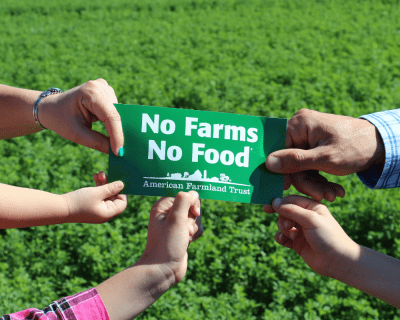CEO, American Farmland Trust
In this issue’s Q&A, Texas+Water Editor-in-Chief, Dr. Todd Votteler, interviews John Piotti, President of the American Farmland Trust (AFT).
Piotti has worked at the forefront of sustainable agriculture since the early 1990s, first in his home state of Maine and now nationally. In 2016, he became the President of AFT, bringing new energy to this storied organization that helped create the conservation agriculture movement.
Please tell us what the mission of AFT is and a little about your organization’s history and its greatest achievements?
AFT’s mission is to save the land that sustains us by protecting farmland and ranchland, promoting environmentally-sound farming practices, and keeping farmers on the land.
 AFT is the only national organization that takes a holistic approach to agriculture, focusing on the land itself, the agricultural practices used on that land, and the farmers and ranchers who steward the land. AFT launched the conservation agriculture movement and continues to raise public awareness through our No Farms, No Food message. Since our founding in 1980, AFT has helped permanently protect over 6.8 million acres of agricultural lands, advanced environmentally sound farming practices on millions of additional acres, and supported thousands of farm families.
AFT is the only national organization that takes a holistic approach to agriculture, focusing on the land itself, the agricultural practices used on that land, and the farmers and ranchers who steward the land. AFT launched the conservation agriculture movement and continues to raise public awareness through our No Farms, No Food message. Since our founding in 1980, AFT has helped permanently protect over 6.8 million acres of agricultural lands, advanced environmentally sound farming practices on millions of additional acres, and supported thousands of farm families.
AFT was conceived in the late 1970s, a time when farmers and environmentalists were at odds. Peggy Rockefeller, the wife of financier David Rockefeller and herself a bona fide cattle farmer, organized a small group of national leaders who viewed agriculture and the environment as two sides of the same coin. They believed that America needed an organization that could bring these two sides together.
Perhaps because AFT was the only player in this space at the time, or because of the people that Peggy assembled, the new organization had an outsized impact from almost the beginning. AFT was the force behind passage of the Farmland Protection Policy Act (FPPA) in 1981. AFT then led pioneering efforts to create farmland protection programs in multiple states and help land trusts use conservation easements as an effective tool to support agriculture. As a result of AFT’s work, over 6.8 million acres of farmland have now been permanent protected.
On a parallel path, AFT also actively advanced better farming practices. AFT organized the coalition that led to incorporation of the first-ever conservation title in a farm bill in 1985. Since then, AFT has worked hard to add to and refine federal conservation programs, so that as of today, over $120 billion of federal support has flowed to help farmers do the right thing by the land.
AFT can point to many major accomplishments over its 40+ years, ranging from major federal policy successes to its role raising consumer awareness about the connection between farms and food and helping launch the local food movement. But to my mind, our greatest achievement is that we have changed the nature of the debate — and that has changed everything. Environmental groups that at one time didn’t want to work with farmers now see them as natural partners. And agricultural groups that at one time viewed environmentalists so negatively now fully embrace the need for conservation.
Recently, you were part of a program at the Texas Capitol with Texas A&M AgriLife, Texas Parks & Wildlife Department and the Texas Land Trust Council, called “Vanishing Texas: The Pressing Need for Farm and Ranch Land Conservation in the Lone Star State.” What was the goal of that event?
Texas is home to 142 million acres of privately owned farms, ranches, and forestlands. These are vibrant rural working lands supporting food production and wildlife habitat, providing clean and abundant water, and underpinning a robust agricultural economy. The lands have long been under threat from urban sprawl, suburbanization, and fragmentation — farms and ranches being divided up into large lot housing parcels.
In 2005, AFT brought together leaders of Texas’ statewide agricultural, wildlife, and landowners’ organizations. This convening resulted in the creation of the Texas Agricultural Land Trust (TALT), which has done such good work. AFT applauds the efforts of both TALT and the Texas Land Trust Council (TLTC) to help stem the loss of Texas’ irreplaceable working lands.
AFT was one of many partners of TLTC’s “Vanishing Texas” event held at the state capitol and its annual conference, which followed the capitol event.
At the capitol event, I co-presented with Dr. Roel Lopez, Director of the Texas A&M University Natural Resources Institute and Department Head of the Texas A&M Department of Rangeland, Wildlife, and Fisheries Management. We both talked about the tremendous pressures being placed on working lands in Texas and how far more state support is needed. I summarized the alarming statistics for Texas and also pointed out how far behind other states Texas is in advancing policy solutions.
How do efforts in Texas compare to efforts of other states that are trying to preserve farm and ranch land?
First, let me say that at AFT, we focus on both farmland and ranchland, but we often say just farmland to mean all agricultural land.
Texas farmland is the most threatened in the nation. Texas ranked #1 in farmland loss in AFT’s 2020 report, “Farms Under Threat: The State of the States Report.” The hot spots for development in Texas are around Austin, Dallas-Fort Worth, Houston, Odessa, and San Antonio.
 AFT’s research showed that almost 1.4 million acres of Texas farmland and ranchland had been paved over, fragmented, or compromised by development between 2001 and 2016. This is the result of both urban sprawl and what AFT calls “low-density residential” development. That’s where large tracts of open land in rural areas get developed or fragmented in ways that make commercial agriculture impossible. In some places, this plays out as McMansions or “ranchettes” or small hobby farms. It’s what I sometimes refer to as properties that are “too large to mow, but too small to grow.”
AFT’s research showed that almost 1.4 million acres of Texas farmland and ranchland had been paved over, fragmented, or compromised by development between 2001 and 2016. This is the result of both urban sprawl and what AFT calls “low-density residential” development. That’s where large tracts of open land in rural areas get developed or fragmented in ways that make commercial agriculture impossible. In some places, this plays out as McMansions or “ranchettes” or small hobby farms. It’s what I sometimes refer to as properties that are “too large to mow, but too small to grow.”
A growing population and lack of adequate public policy to protect farmland are the culprits for the conversion of farmland in Texas. Lots of people want to live in Texas and of course the pandemic has only increased the problem with remote work giving people greater flexibility as to where they can live.
Development is a national issue, with 11 million acres succumbing across the United States between 2001 and 2016. However, there’s a great deal Texas could do that it hasn’t done. States like New Jersey, Delaware, Maryland, and Pennsylvania have faced severe threats to farmland but have responded aggressively and to good effect. Texas has a very low policy response. One example I shared how many states have invested hundreds of millions of dollars in farmland protection, while in Texas, despite the phenomenal development pressure here, the state program has invested less than $10 million.
In its report, AFT outlines six programs and policies that are key to states securing their farmland. Texas lags behind all but a handful of other states in each of these areas. And given that Texas is the most threatened state, if anything, it should have among the most robust programs.
But there is good news too. TALT has been doing good work and is now ramping up to do even more. More broadly, there seems to be a growing public awareness that Texas is losing its working lands, coupled with a growing willingness to invest in farmland protection. Texas may be behind other states, but it is heading in the right direction. It just needs to do more — and soon!
What do you think is most important for Texans to know about the value and the status of farm and ranch land in the Lone Star state?
Over 33 million acres of Texas land is “nationally significant” land. These acres represent the best soils in the nation, what AFT describes as high PVR soils — the most productive, versatile, and resilient soils we have. They are absolutely critical to securing our food supply.
Sadly, Texas is losing its “nationally significant” land twice as fast as it is losing other farmland.
Of course, the loss of farmland and ranchland does not just threaten the Texas food supply, it threatens the economy. Texas is an agricultural state with $24.9 billion in annual revenues from farms, $7.2 billion in agricultural exports, and a thriving local food economy that exceeds a quarter of a billion dollars.
Beyond that, this land is also needed to provide essential environmental services such as water recharge, wildlife habitat, and capturing atmospheric carbon in soil.
Texas is going to want and need this land — to grow food, support the economy, and help maintain a livable environment.
What efforts will AFT pursue in Texas going forward?
Between this latest research, which shows how threatened Texas farmland is, and the growing public awareness of these issues, which increases the likelihood that good progress can be made, AFT intends to make work in Texas a far greater priority.
We’ve always been supportive of TALT and TLTC but now intend to do even more to be helpful. And that is exactly how we would try to advance efforts in Texas, by being helpful — by assisting the existing organizations that are doing good work on the ground. We can provide research data, we can partner on projects, and we can help advance policy; but we will do all it in partnership with local players.
We could not envision better partners than Chad Ellis at TALT and Lori Olson at TLTC. They are both highly creative, capable, visionary leaders. Together, we can make happen what needs to happen in Texas — to secure the future of agriculture in this great state.
Join Our Mailing List
Subscribe to Texas+Water and stay updated on the spectrum of Texas water issues including science, policy, and law.

